BTEC HND Unit 9: Entrepreneurship and Small Business Report
VerifiedAdded on 2020/12/09
|13
|3002
|385
Report
AI Summary
This report delves into the realm of entrepreneurship and small business management, beginning with an exploration of various entrepreneurial ventures, including small, medium, large, and social business ventures. It then examines the impact of small businesses on the economy, highlighting their significant contribution to employment, turnover, and overall economic growth. The report further analyzes the characteristics, traits, skills, and motivational drivers of entrepreneurs, differentiating them from managers. It also investigates how an entrepreneur's background and experience can either hinder or foster their entrepreneurial skills. The report provides a comprehensive overview of the subject, covering key aspects of entrepreneurial ventures and the importance of small businesses to the economy.

Entrepreneurship and Small
Business Management
Business Management
Paraphrase This Document
Need a fresh take? Get an instant paraphrase of this document with our AI Paraphraser
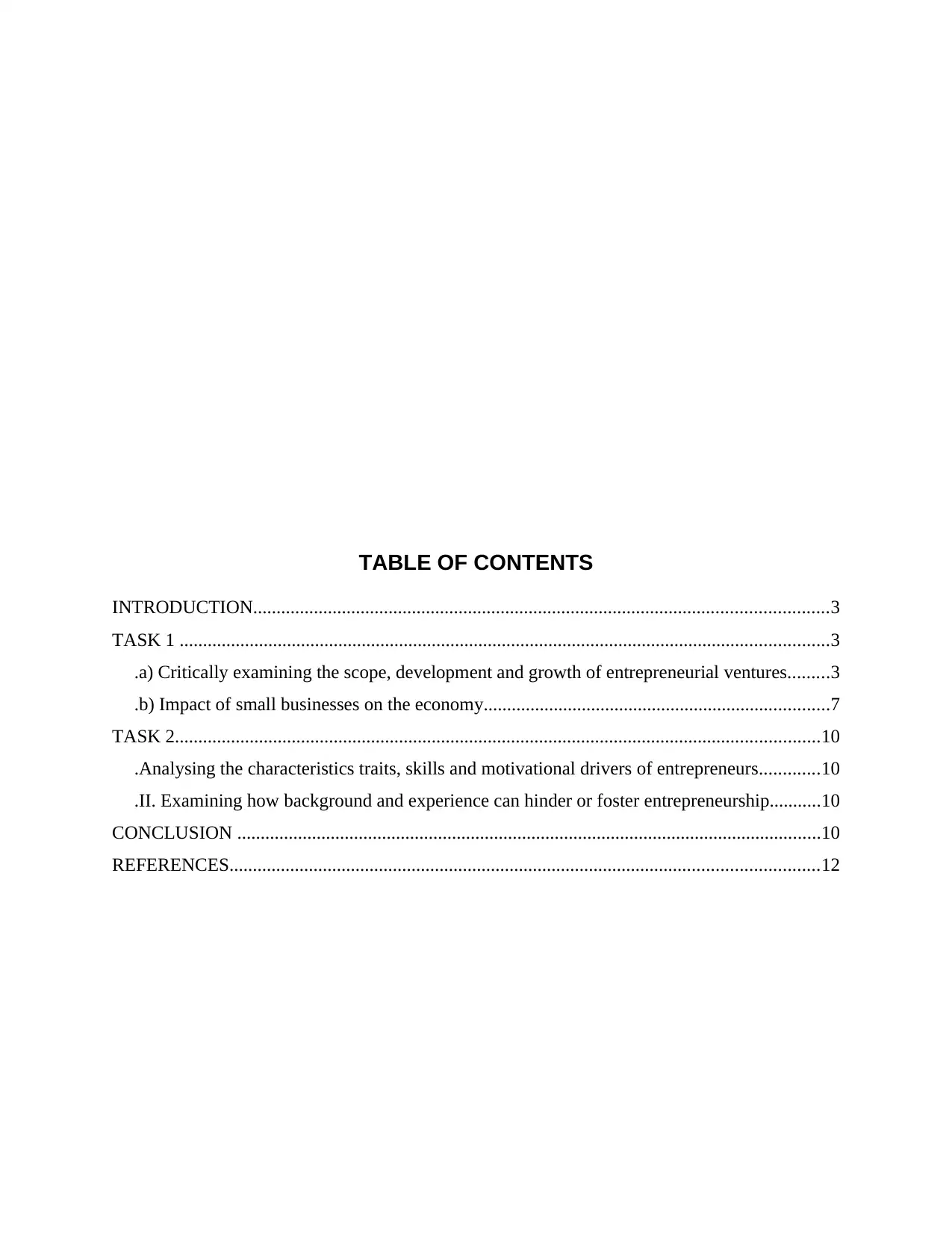
TABLE OF CONTENTS
INTRODUCTION...........................................................................................................................3
TASK 1 ...........................................................................................................................................3
.a) Critically examining the scope, development and growth of entrepreneurial ventures.........3
.b) Impact of small businesses on the economy..........................................................................7
TASK 2..........................................................................................................................................10
.Analysing the characteristics traits, skills and motivational drivers of entrepreneurs.............10
.II. Examining how background and experience can hinder or foster entrepreneurship...........10
CONCLUSION .............................................................................................................................10
REFERENCES..............................................................................................................................12
INTRODUCTION...........................................................................................................................3
TASK 1 ...........................................................................................................................................3
.a) Critically examining the scope, development and growth of entrepreneurial ventures.........3
.b) Impact of small businesses on the economy..........................................................................7
TASK 2..........................................................................................................................................10
.Analysing the characteristics traits, skills and motivational drivers of entrepreneurs.............10
.II. Examining how background and experience can hinder or foster entrepreneurship...........10
CONCLUSION .............................................................................................................................10
REFERENCES..............................................................................................................................12
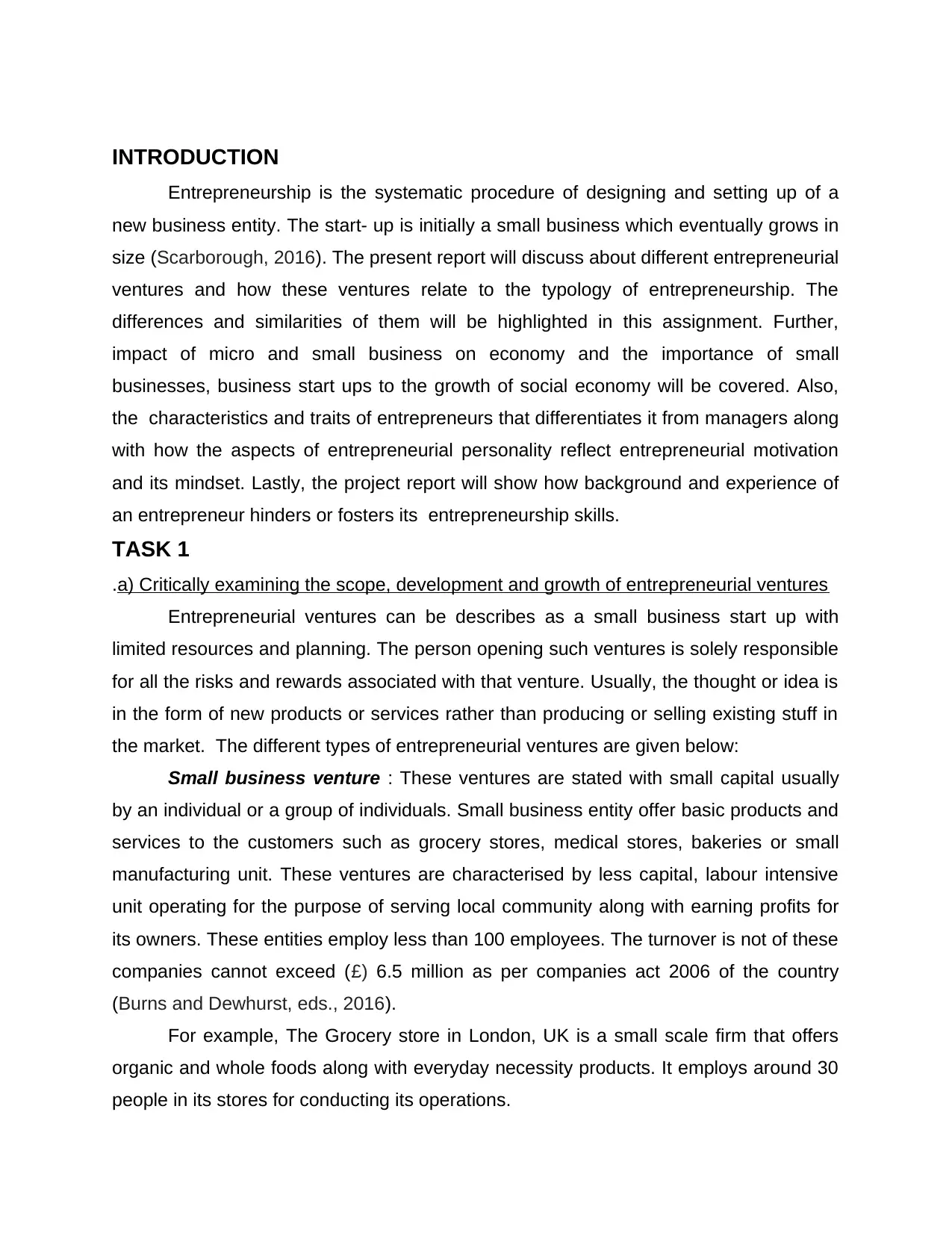
INTRODUCTION
Entrepreneurship is the systematic procedure of designing and setting up of a
new business entity. The start- up is initially a small business which eventually grows in
size (Scarborough, 2016). The present report will discuss about different entrepreneurial
ventures and how these ventures relate to the typology of entrepreneurship. The
differences and similarities of them will be highlighted in this assignment. Further,
impact of micro and small business on economy and the importance of small
businesses, business start ups to the growth of social economy will be covered. Also,
the characteristics and traits of entrepreneurs that differentiates it from managers along
with how the aspects of entrepreneurial personality reflect entrepreneurial motivation
and its mindset. Lastly, the project report will show how background and experience of
an entrepreneur hinders or fosters its entrepreneurship skills.
TASK 1
.a) Critically examining the scope, development and growth of entrepreneurial ventures
Entrepreneurial ventures can be describes as a small business start up with
limited resources and planning. The person opening such ventures is solely responsible
for all the risks and rewards associated with that venture. Usually, the thought or idea is
in the form of new products or services rather than producing or selling existing stuff in
the market. The different types of entrepreneurial ventures are given below:
Small business venture : These ventures are stated with small capital usually
by an individual or a group of individuals. Small business entity offer basic products and
services to the customers such as grocery stores, medical stores, bakeries or small
manufacturing unit. These ventures are characterised by less capital, labour intensive
unit operating for the purpose of serving local community along with earning profits for
its owners. These entities employ less than 100 employees. The turnover is not of these
companies cannot exceed (£) 6.5 million as per companies act 2006 of the country
(Burns and Dewhurst, eds., 2016).
For example, The Grocery store in London, UK is a small scale firm that offers
organic and whole foods along with everyday necessity products. It employs around 30
people in its stores for conducting its operations.
Entrepreneurship is the systematic procedure of designing and setting up of a
new business entity. The start- up is initially a small business which eventually grows in
size (Scarborough, 2016). The present report will discuss about different entrepreneurial
ventures and how these ventures relate to the typology of entrepreneurship. The
differences and similarities of them will be highlighted in this assignment. Further,
impact of micro and small business on economy and the importance of small
businesses, business start ups to the growth of social economy will be covered. Also,
the characteristics and traits of entrepreneurs that differentiates it from managers along
with how the aspects of entrepreneurial personality reflect entrepreneurial motivation
and its mindset. Lastly, the project report will show how background and experience of
an entrepreneur hinders or fosters its entrepreneurship skills.
TASK 1
.a) Critically examining the scope, development and growth of entrepreneurial ventures
Entrepreneurial ventures can be describes as a small business start up with
limited resources and planning. The person opening such ventures is solely responsible
for all the risks and rewards associated with that venture. Usually, the thought or idea is
in the form of new products or services rather than producing or selling existing stuff in
the market. The different types of entrepreneurial ventures are given below:
Small business venture : These ventures are stated with small capital usually
by an individual or a group of individuals. Small business entity offer basic products and
services to the customers such as grocery stores, medical stores, bakeries or small
manufacturing unit. These ventures are characterised by less capital, labour intensive
unit operating for the purpose of serving local community along with earning profits for
its owners. These entities employ less than 100 employees. The turnover is not of these
companies cannot exceed (£) 6.5 million as per companies act 2006 of the country
(Burns and Dewhurst, eds., 2016).
For example, The Grocery store in London, UK is a small scale firm that offers
organic and whole foods along with everyday necessity products. It employs around 30
people in its stores for conducting its operations.
⊘ This is a preview!⊘
Do you want full access?
Subscribe today to unlock all pages.

Trusted by 1+ million students worldwide
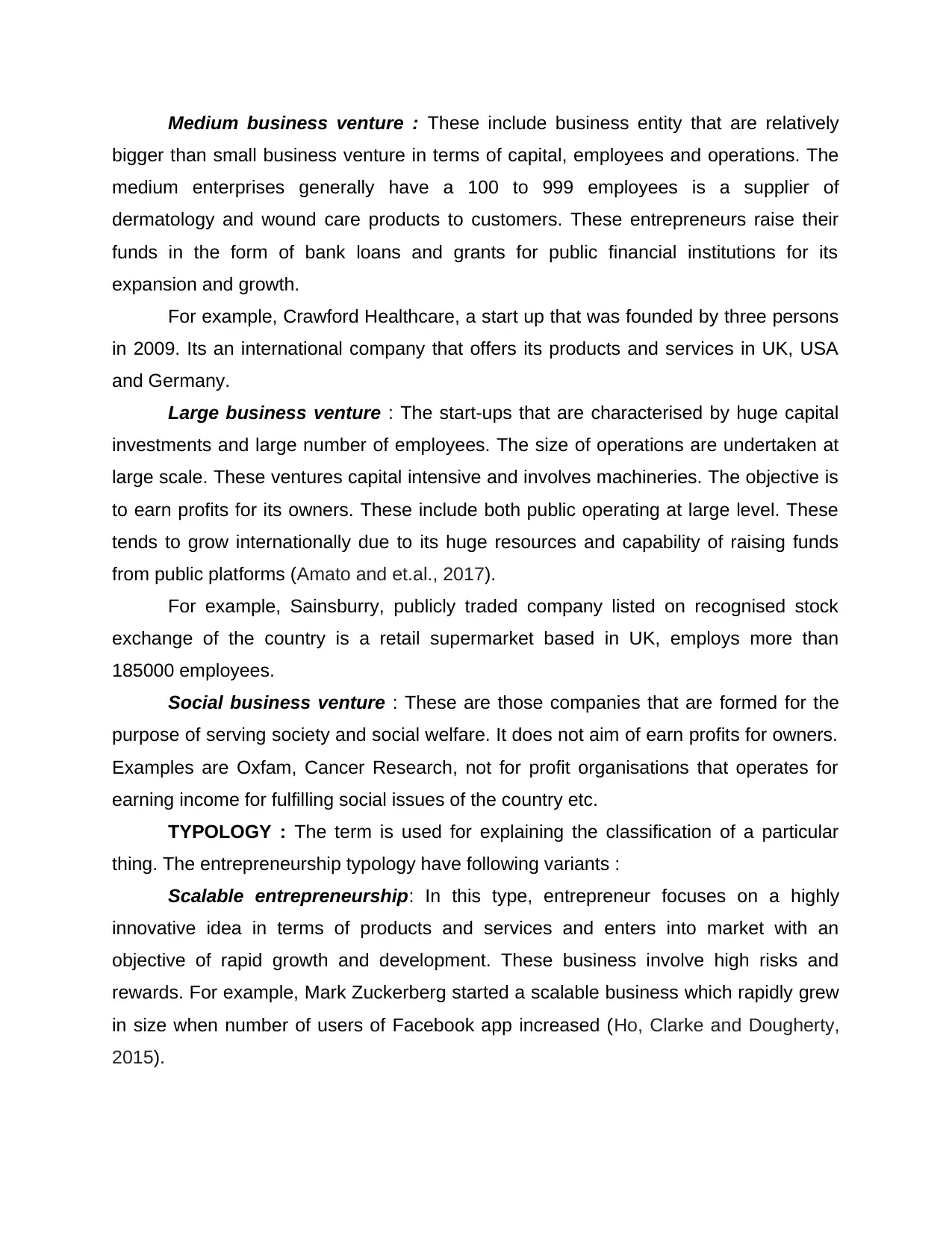
Medium business venture : These include business entity that are relatively
bigger than small business venture in terms of capital, employees and operations. The
medium enterprises generally have a 100 to 999 employees is a supplier of
dermatology and wound care products to customers. These entrepreneurs raise their
funds in the form of bank loans and grants for public financial institutions for its
expansion and growth.
For example, Crawford Healthcare, a start up that was founded by three persons
in 2009. Its an international company that offers its products and services in UK, USA
and Germany.
Large business venture : The start-ups that are characterised by huge capital
investments and large number of employees. The size of operations are undertaken at
large scale. These ventures capital intensive and involves machineries. The objective is
to earn profits for its owners. These include both public operating at large level. These
tends to grow internationally due to its huge resources and capability of raising funds
from public platforms (Amato and et.al., 2017).
For example, Sainsburry, publicly traded company listed on recognised stock
exchange of the country is a retail supermarket based in UK, employs more than
185000 employees.
Social business venture : These are those companies that are formed for the
purpose of serving society and social welfare. It does not aim of earn profits for owners.
Examples are Oxfam, Cancer Research, not for profit organisations that operates for
earning income for fulfilling social issues of the country etc.
TYPOLOGY : The term is used for explaining the classification of a particular
thing. The entrepreneurship typology have following variants :
Scalable entrepreneurship: In this type, entrepreneur focuses on a highly
innovative idea in terms of products and services and enters into market with an
objective of rapid growth and development. These business involve high risks and
rewards. For example, Mark Zuckerberg started a scalable business which rapidly grew
in size when number of users of Facebook app increased (Ho, Clarke and Dougherty,
2015).
bigger than small business venture in terms of capital, employees and operations. The
medium enterprises generally have a 100 to 999 employees is a supplier of
dermatology and wound care products to customers. These entrepreneurs raise their
funds in the form of bank loans and grants for public financial institutions for its
expansion and growth.
For example, Crawford Healthcare, a start up that was founded by three persons
in 2009. Its an international company that offers its products and services in UK, USA
and Germany.
Large business venture : The start-ups that are characterised by huge capital
investments and large number of employees. The size of operations are undertaken at
large scale. These ventures capital intensive and involves machineries. The objective is
to earn profits for its owners. These include both public operating at large level. These
tends to grow internationally due to its huge resources and capability of raising funds
from public platforms (Amato and et.al., 2017).
For example, Sainsburry, publicly traded company listed on recognised stock
exchange of the country is a retail supermarket based in UK, employs more than
185000 employees.
Social business venture : These are those companies that are formed for the
purpose of serving society and social welfare. It does not aim of earn profits for owners.
Examples are Oxfam, Cancer Research, not for profit organisations that operates for
earning income for fulfilling social issues of the country etc.
TYPOLOGY : The term is used for explaining the classification of a particular
thing. The entrepreneurship typology have following variants :
Scalable entrepreneurship: In this type, entrepreneur focuses on a highly
innovative idea in terms of products and services and enters into market with an
objective of rapid growth and development. These business involve high risks and
rewards. For example, Mark Zuckerberg started a scalable business which rapidly grew
in size when number of users of Facebook app increased (Ho, Clarke and Dougherty,
2015).
Paraphrase This Document
Need a fresh take? Get an instant paraphrase of this document with our AI Paraphraser
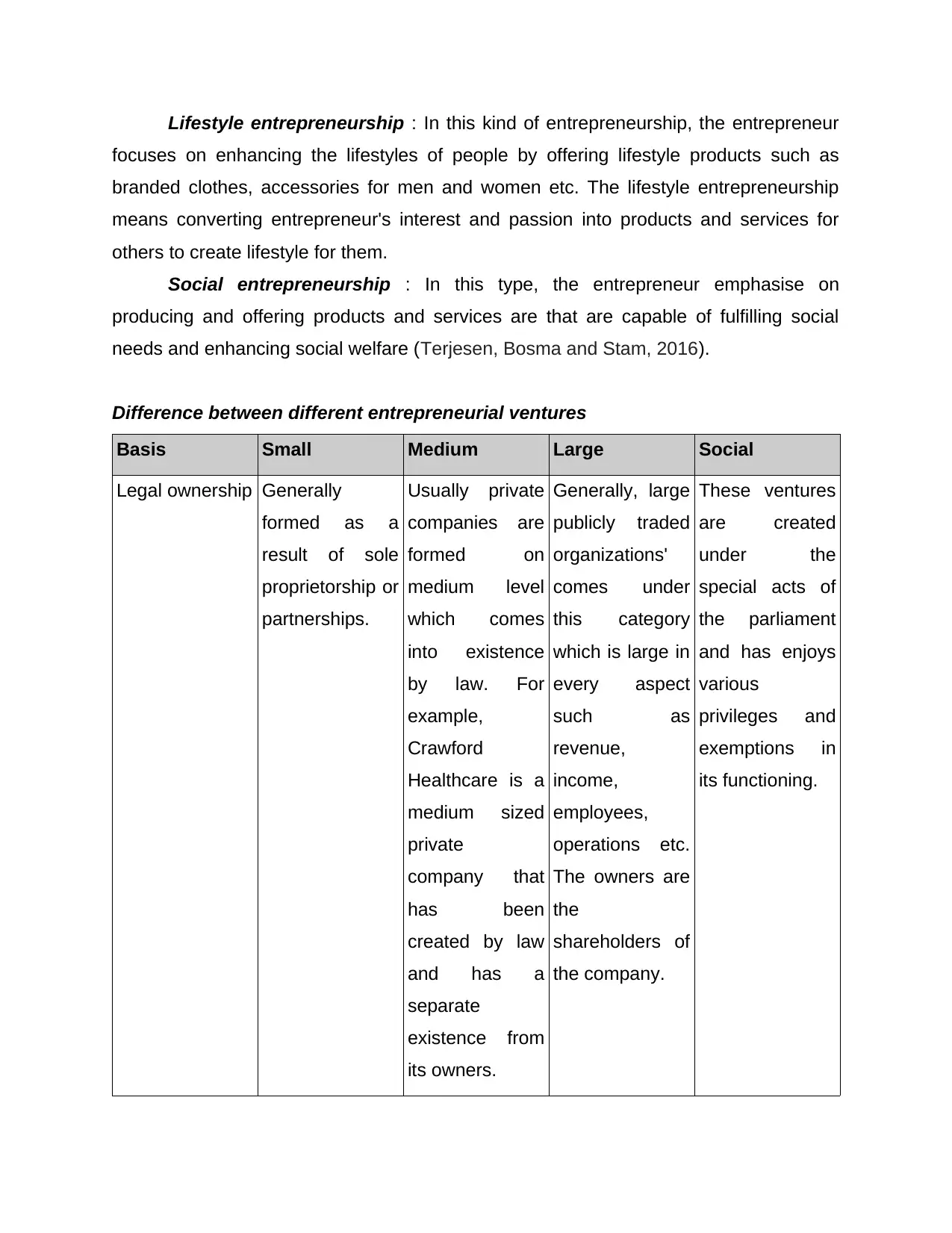
Lifestyle entrepreneurship : In this kind of entrepreneurship, the entrepreneur
focuses on enhancing the lifestyles of people by offering lifestyle products such as
branded clothes, accessories for men and women etc. The lifestyle entrepreneurship
means converting entrepreneur's interest and passion into products and services for
others to create lifestyle for them.
Social entrepreneurship : In this type, the entrepreneur emphasise on
producing and offering products and services are that are capable of fulfilling social
needs and enhancing social welfare (Terjesen, Bosma and Stam, 2016).
Difference between different entrepreneurial ventures
Basis Small Medium Large Social
Legal ownership Generally
formed as a
result of sole
proprietorship or
partnerships.
Usually private
companies are
formed on
medium level
which comes
into existence
by law. For
example,
Crawford
Healthcare is a
medium sized
private
company that
has been
created by law
and has a
separate
existence from
its owners.
Generally, large
publicly traded
organizations'
comes under
this category
which is large in
every aspect
such as
revenue,
income,
employees,
operations etc.
The owners are
the
shareholders of
the company.
These ventures
are created
under the
special acts of
the parliament
and has enjoys
various
privileges and
exemptions in
its functioning.
focuses on enhancing the lifestyles of people by offering lifestyle products such as
branded clothes, accessories for men and women etc. The lifestyle entrepreneurship
means converting entrepreneur's interest and passion into products and services for
others to create lifestyle for them.
Social entrepreneurship : In this type, the entrepreneur emphasise on
producing and offering products and services are that are capable of fulfilling social
needs and enhancing social welfare (Terjesen, Bosma and Stam, 2016).
Difference between different entrepreneurial ventures
Basis Small Medium Large Social
Legal ownership Generally
formed as a
result of sole
proprietorship or
partnerships.
Usually private
companies are
formed on
medium level
which comes
into existence
by law. For
example,
Crawford
Healthcare is a
medium sized
private
company that
has been
created by law
and has a
separate
existence from
its owners.
Generally, large
publicly traded
organizations'
comes under
this category
which is large in
every aspect
such as
revenue,
income,
employees,
operations etc.
The owners are
the
shareholders of
the company.
These ventures
are created
under the
special acts of
the parliament
and has enjoys
various
privileges and
exemptions in
its functioning.
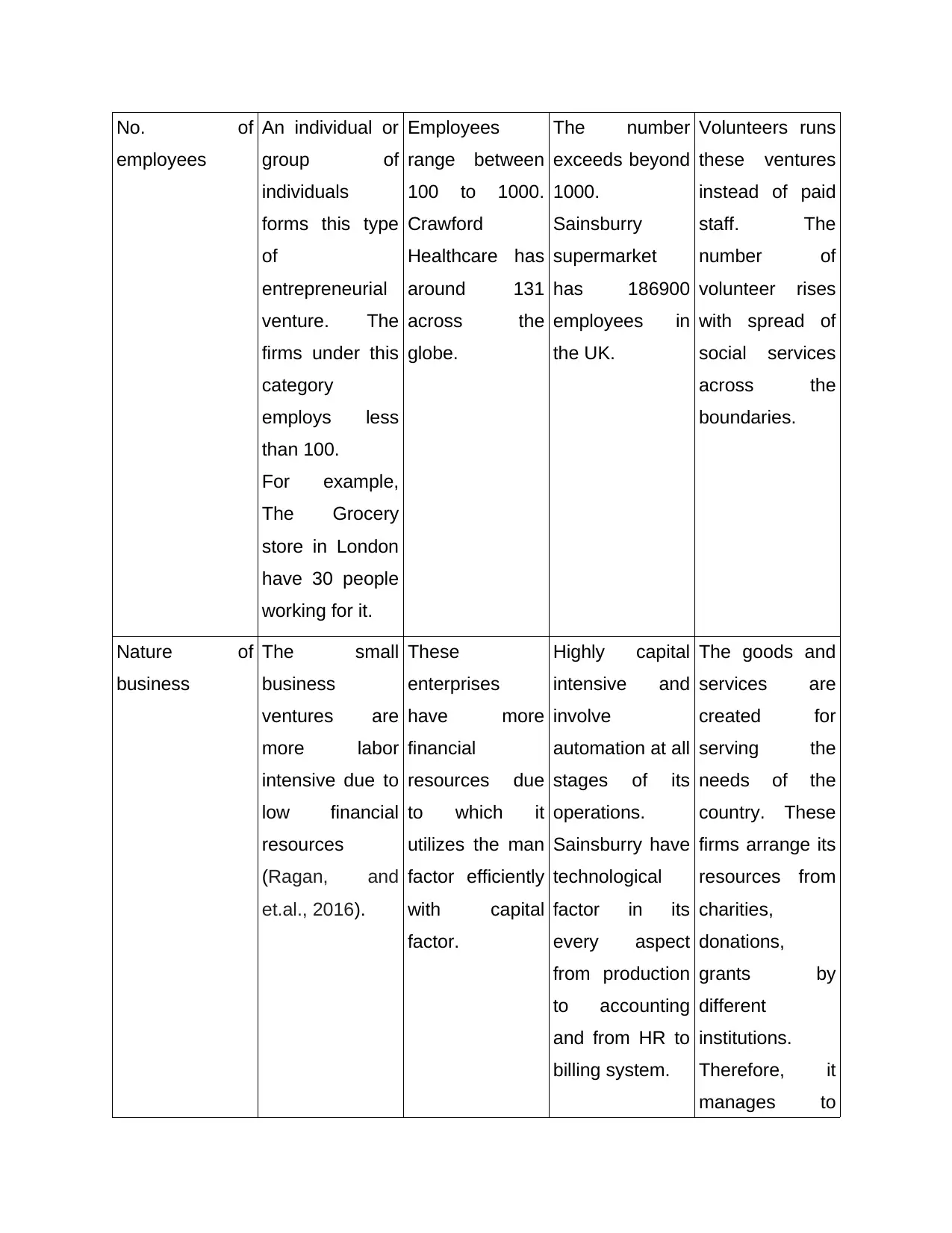
No. of
employees
An individual or
group of
individuals
forms this type
of
entrepreneurial
venture. The
firms under this
category
employs less
than 100.
For example,
The Grocery
store in London
have 30 people
working for it.
Employees
range between
100 to 1000.
Crawford
Healthcare has
around 131
across the
globe.
The number
exceeds beyond
1000.
Sainsburry
supermarket
has 186900
employees in
the UK.
Volunteers runs
these ventures
instead of paid
staff. The
number of
volunteer rises
with spread of
social services
across the
boundaries.
Nature of
business
The small
business
ventures are
more labor
intensive due to
low financial
resources
(Ragan, and
et.al., 2016).
These
enterprises
have more
financial
resources due
to which it
utilizes the man
factor efficiently
with capital
factor.
Highly capital
intensive and
involve
automation at all
stages of its
operations.
Sainsburry have
technological
factor in its
every aspect
from production
to accounting
and from HR to
billing system.
The goods and
services are
created for
serving the
needs of the
country. These
firms arrange its
resources from
charities,
donations,
grants by
different
institutions.
Therefore, it
manages to
employees
An individual or
group of
individuals
forms this type
of
entrepreneurial
venture. The
firms under this
category
employs less
than 100.
For example,
The Grocery
store in London
have 30 people
working for it.
Employees
range between
100 to 1000.
Crawford
Healthcare has
around 131
across the
globe.
The number
exceeds beyond
1000.
Sainsburry
supermarket
has 186900
employees in
the UK.
Volunteers runs
these ventures
instead of paid
staff. The
number of
volunteer rises
with spread of
social services
across the
boundaries.
Nature of
business
The small
business
ventures are
more labor
intensive due to
low financial
resources
(Ragan, and
et.al., 2016).
These
enterprises
have more
financial
resources due
to which it
utilizes the man
factor efficiently
with capital
factor.
Highly capital
intensive and
involve
automation at all
stages of its
operations.
Sainsburry have
technological
factor in its
every aspect
from production
to accounting
and from HR to
billing system.
The goods and
services are
created for
serving the
needs of the
country. These
firms arrange its
resources from
charities,
donations,
grants by
different
institutions.
Therefore, it
manages to
⊘ This is a preview!⊘
Do you want full access?
Subscribe today to unlock all pages.

Trusted by 1+ million students worldwide
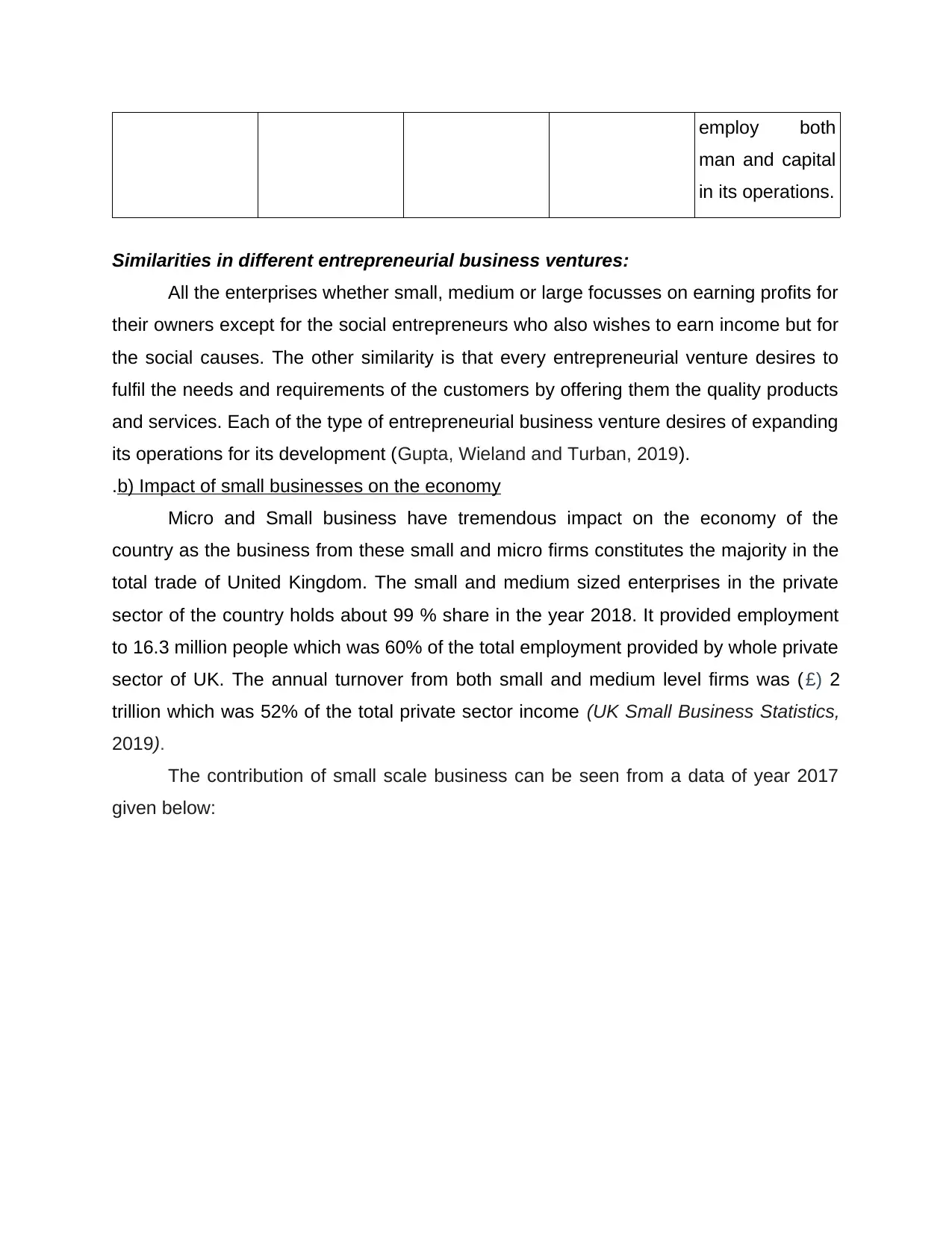
employ both
man and capital
in its operations.
Similarities in different entrepreneurial business ventures:
All the enterprises whether small, medium or large focusses on earning profits for
their owners except for the social entrepreneurs who also wishes to earn income but for
the social causes. The other similarity is that every entrepreneurial venture desires to
fulfil the needs and requirements of the customers by offering them the quality products
and services. Each of the type of entrepreneurial business venture desires of expanding
its operations for its development (Gupta, Wieland and Turban, 2019).
.b) Impact of small businesses on the economy
Micro and Small business have tremendous impact on the economy of the
country as the business from these small and micro firms constitutes the majority in the
total trade of United Kingdom. The small and medium sized enterprises in the private
sector of the country holds about 99 % share in the year 2018. It provided employment
to 16.3 million people which was 60% of the total employment provided by whole private
sector of UK. The annual turnover from both small and medium level firms was ( £) 2
trillion which was 52% of the total private sector income (UK Small Business Statistics,
2019).
The contribution of small scale business can be seen from a data of year 2017
given below:
man and capital
in its operations.
Similarities in different entrepreneurial business ventures:
All the enterprises whether small, medium or large focusses on earning profits for
their owners except for the social entrepreneurs who also wishes to earn income but for
the social causes. The other similarity is that every entrepreneurial venture desires to
fulfil the needs and requirements of the customers by offering them the quality products
and services. Each of the type of entrepreneurial business venture desires of expanding
its operations for its development (Gupta, Wieland and Turban, 2019).
.b) Impact of small businesses on the economy
Micro and Small business have tremendous impact on the economy of the
country as the business from these small and micro firms constitutes the majority in the
total trade of United Kingdom. The small and medium sized enterprises in the private
sector of the country holds about 99 % share in the year 2018. It provided employment
to 16.3 million people which was 60% of the total employment provided by whole private
sector of UK. The annual turnover from both small and medium level firms was ( £) 2
trillion which was 52% of the total private sector income (UK Small Business Statistics,
2019).
The contribution of small scale business can be seen from a data of year 2017
given below:
Paraphrase This Document
Need a fresh take? Get an instant paraphrase of this document with our AI Paraphraser
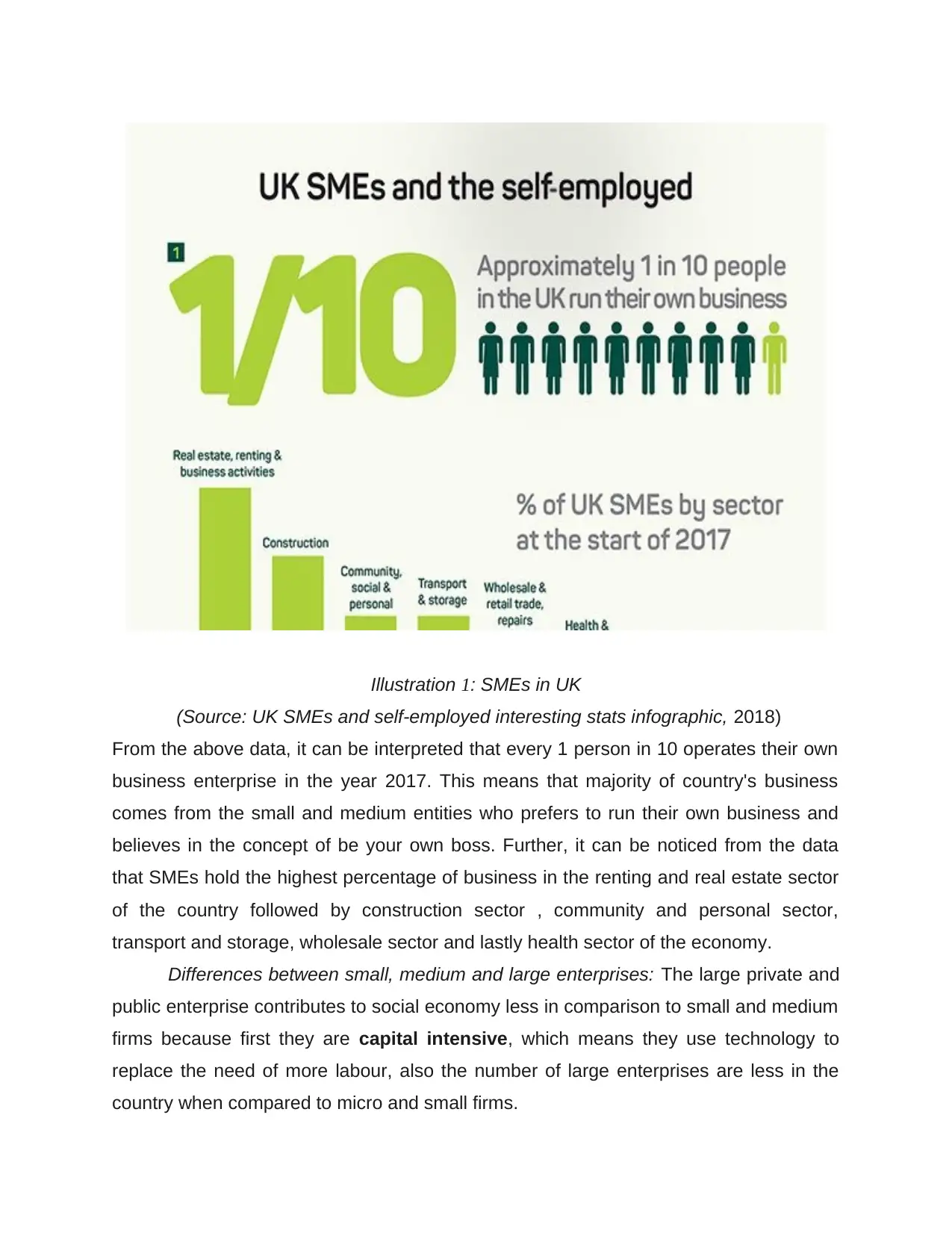
Illustration 1: SMEs in UK
(Source: UK SMEs and self-employed interesting stats infographic, 2018)
From the above data, it can be interpreted that every 1 person in 10 operates their own
business enterprise in the year 2017. This means that majority of country's business
comes from the small and medium entities who prefers to run their own business and
believes in the concept of be your own boss. Further, it can be noticed from the data
that SMEs hold the highest percentage of business in the renting and real estate sector
of the country followed by construction sector , community and personal sector,
transport and storage, wholesale sector and lastly health sector of the economy.
Differences between small, medium and large enterprises: The large private and
public enterprise contributes to social economy less in comparison to small and medium
firms because first they are capital intensive, which means they use technology to
replace the need of more labour, also the number of large enterprises are less in the
country when compared to micro and small firms.
(Source: UK SMEs and self-employed interesting stats infographic, 2018)
From the above data, it can be interpreted that every 1 person in 10 operates their own
business enterprise in the year 2017. This means that majority of country's business
comes from the small and medium entities who prefers to run their own business and
believes in the concept of be your own boss. Further, it can be noticed from the data
that SMEs hold the highest percentage of business in the renting and real estate sector
of the country followed by construction sector , community and personal sector,
transport and storage, wholesale sector and lastly health sector of the economy.
Differences between small, medium and large enterprises: The large private and
public enterprise contributes to social economy less in comparison to small and medium
firms because first they are capital intensive, which means they use technology to
replace the need of more labour, also the number of large enterprises are less in the
country when compared to micro and small firms.
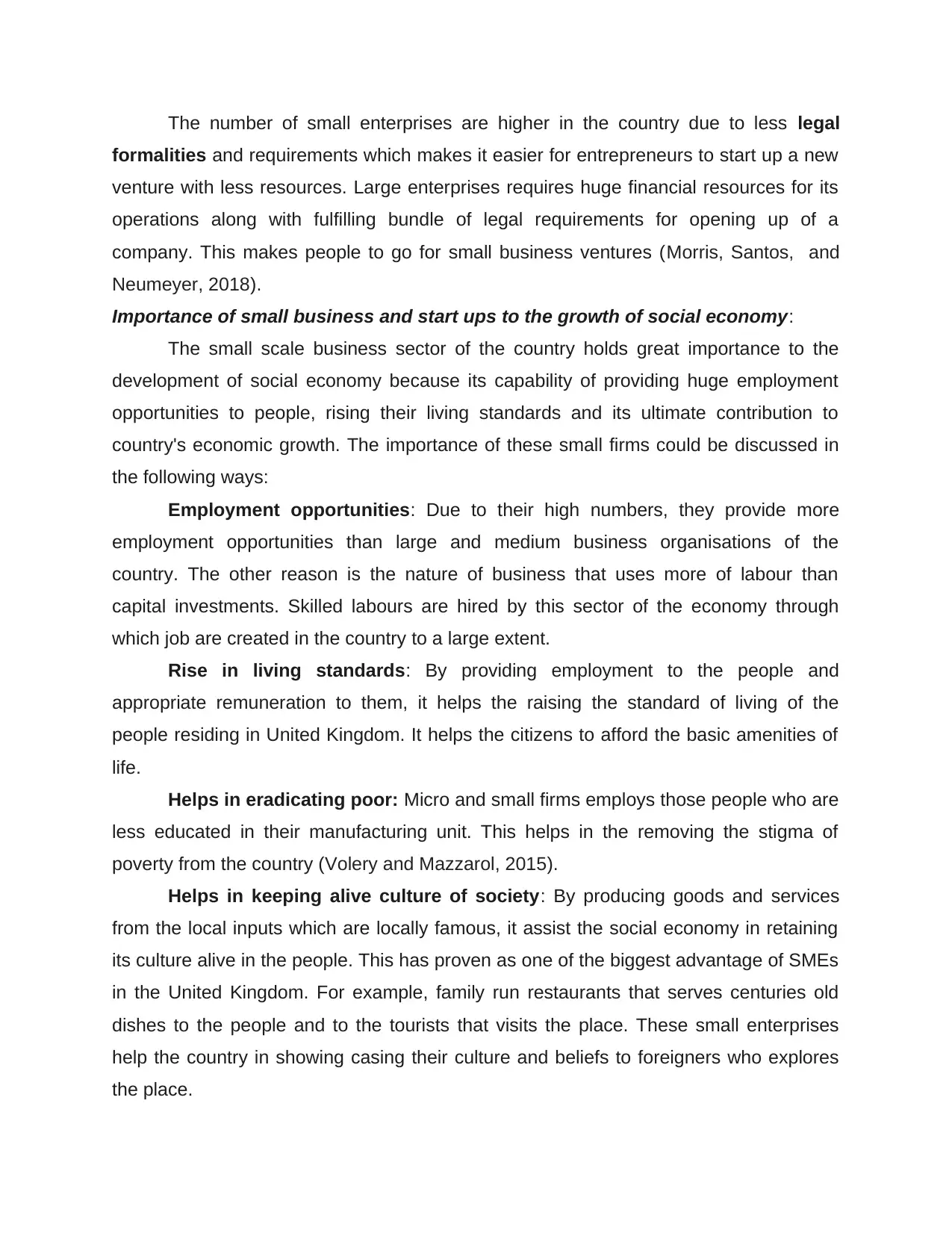
The number of small enterprises are higher in the country due to less legal
formalities and requirements which makes it easier for entrepreneurs to start up a new
venture with less resources. Large enterprises requires huge financial resources for its
operations along with fulfilling bundle of legal requirements for opening up of a
company. This makes people to go for small business ventures (Morris, Santos, and
Neumeyer, 2018).
Importance of small business and start ups to the growth of social economy:
The small scale business sector of the country holds great importance to the
development of social economy because its capability of providing huge employment
opportunities to people, rising their living standards and its ultimate contribution to
country's economic growth. The importance of these small firms could be discussed in
the following ways:
Employment opportunities: Due to their high numbers, they provide more
employment opportunities than large and medium business organisations of the
country. The other reason is the nature of business that uses more of labour than
capital investments. Skilled labours are hired by this sector of the economy through
which job are created in the country to a large extent.
Rise in living standards: By providing employment to the people and
appropriate remuneration to them, it helps the raising the standard of living of the
people residing in United Kingdom. It helps the citizens to afford the basic amenities of
life.
Helps in eradicating poor: Micro and small firms employs those people who are
less educated in their manufacturing unit. This helps in the removing the stigma of
poverty from the country (Volery and Mazzarol, 2015).
Helps in keeping alive culture of society: By producing goods and services
from the local inputs which are locally famous, it assist the social economy in retaining
its culture alive in the people. This has proven as one of the biggest advantage of SMEs
in the United Kingdom. For example, family run restaurants that serves centuries old
dishes to the people and to the tourists that visits the place. These small enterprises
help the country in showing casing their culture and beliefs to foreigners who explores
the place.
formalities and requirements which makes it easier for entrepreneurs to start up a new
venture with less resources. Large enterprises requires huge financial resources for its
operations along with fulfilling bundle of legal requirements for opening up of a
company. This makes people to go for small business ventures (Morris, Santos, and
Neumeyer, 2018).
Importance of small business and start ups to the growth of social economy:
The small scale business sector of the country holds great importance to the
development of social economy because its capability of providing huge employment
opportunities to people, rising their living standards and its ultimate contribution to
country's economic growth. The importance of these small firms could be discussed in
the following ways:
Employment opportunities: Due to their high numbers, they provide more
employment opportunities than large and medium business organisations of the
country. The other reason is the nature of business that uses more of labour than
capital investments. Skilled labours are hired by this sector of the economy through
which job are created in the country to a large extent.
Rise in living standards: By providing employment to the people and
appropriate remuneration to them, it helps the raising the standard of living of the
people residing in United Kingdom. It helps the citizens to afford the basic amenities of
life.
Helps in eradicating poor: Micro and small firms employs those people who are
less educated in their manufacturing unit. This helps in the removing the stigma of
poverty from the country (Volery and Mazzarol, 2015).
Helps in keeping alive culture of society: By producing goods and services
from the local inputs which are locally famous, it assist the social economy in retaining
its culture alive in the people. This has proven as one of the biggest advantage of SMEs
in the United Kingdom. For example, family run restaurants that serves centuries old
dishes to the people and to the tourists that visits the place. These small enterprises
help the country in showing casing their culture and beliefs to foreigners who explores
the place.
⊘ This is a preview!⊘
Do you want full access?
Subscribe today to unlock all pages.

Trusted by 1+ million students worldwide
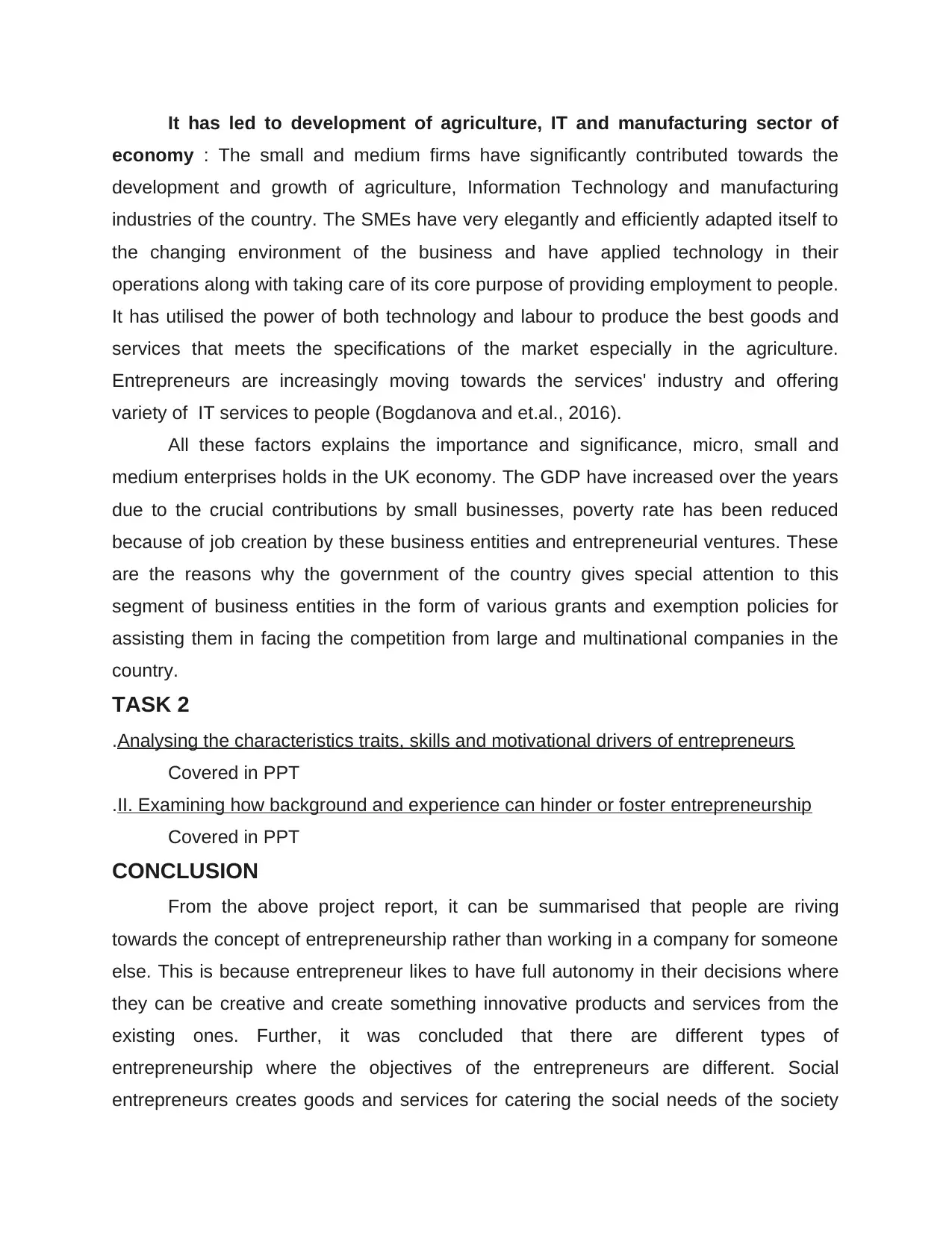
It has led to development of agriculture, IT and manufacturing sector of
economy : The small and medium firms have significantly contributed towards the
development and growth of agriculture, Information Technology and manufacturing
industries of the country. The SMEs have very elegantly and efficiently adapted itself to
the changing environment of the business and have applied technology in their
operations along with taking care of its core purpose of providing employment to people.
It has utilised the power of both technology and labour to produce the best goods and
services that meets the specifications of the market especially in the agriculture.
Entrepreneurs are increasingly moving towards the services' industry and offering
variety of IT services to people (Bogdanova and et.al., 2016).
All these factors explains the importance and significance, micro, small and
medium enterprises holds in the UK economy. The GDP have increased over the years
due to the crucial contributions by small businesses, poverty rate has been reduced
because of job creation by these business entities and entrepreneurial ventures. These
are the reasons why the government of the country gives special attention to this
segment of business entities in the form of various grants and exemption policies for
assisting them in facing the competition from large and multinational companies in the
country.
TASK 2
.Analysing the characteristics traits, skills and motivational drivers of entrepreneurs
Covered in PPT
.II. Examining how background and experience can hinder or foster entrepreneurship
Covered in PPT
CONCLUSION
From the above project report, it can be summarised that people are riving
towards the concept of entrepreneurship rather than working in a company for someone
else. This is because entrepreneur likes to have full autonomy in their decisions where
they can be creative and create something innovative products and services from the
existing ones. Further, it was concluded that there are different types of
entrepreneurship where the objectives of the entrepreneurs are different. Social
entrepreneurs creates goods and services for catering the social needs of the society
economy : The small and medium firms have significantly contributed towards the
development and growth of agriculture, Information Technology and manufacturing
industries of the country. The SMEs have very elegantly and efficiently adapted itself to
the changing environment of the business and have applied technology in their
operations along with taking care of its core purpose of providing employment to people.
It has utilised the power of both technology and labour to produce the best goods and
services that meets the specifications of the market especially in the agriculture.
Entrepreneurs are increasingly moving towards the services' industry and offering
variety of IT services to people (Bogdanova and et.al., 2016).
All these factors explains the importance and significance, micro, small and
medium enterprises holds in the UK economy. The GDP have increased over the years
due to the crucial contributions by small businesses, poverty rate has been reduced
because of job creation by these business entities and entrepreneurial ventures. These
are the reasons why the government of the country gives special attention to this
segment of business entities in the form of various grants and exemption policies for
assisting them in facing the competition from large and multinational companies in the
country.
TASK 2
.Analysing the characteristics traits, skills and motivational drivers of entrepreneurs
Covered in PPT
.II. Examining how background and experience can hinder or foster entrepreneurship
Covered in PPT
CONCLUSION
From the above project report, it can be summarised that people are riving
towards the concept of entrepreneurship rather than working in a company for someone
else. This is because entrepreneur likes to have full autonomy in their decisions where
they can be creative and create something innovative products and services from the
existing ones. Further, it was concluded that there are different types of
entrepreneurship where the objectives of the entrepreneurs are different. Social
entrepreneurs creates goods and services for catering the social needs of the society
Paraphrase This Document
Need a fresh take? Get an instant paraphrase of this document with our AI Paraphraser

rather than just focussing on the personal gains. Scalable entrepreneurship in which
start up is opened with a view of rapidly forming into a giant venture. The sole purpose
of this type of entrepreneurship is to produce goods and services that are highly
innovative which can be rapidly grow in the market.
start up is opened with a view of rapidly forming into a giant venture. The sole purpose
of this type of entrepreneurship is to produce goods and services that are highly
innovative which can be rapidly grow in the market.
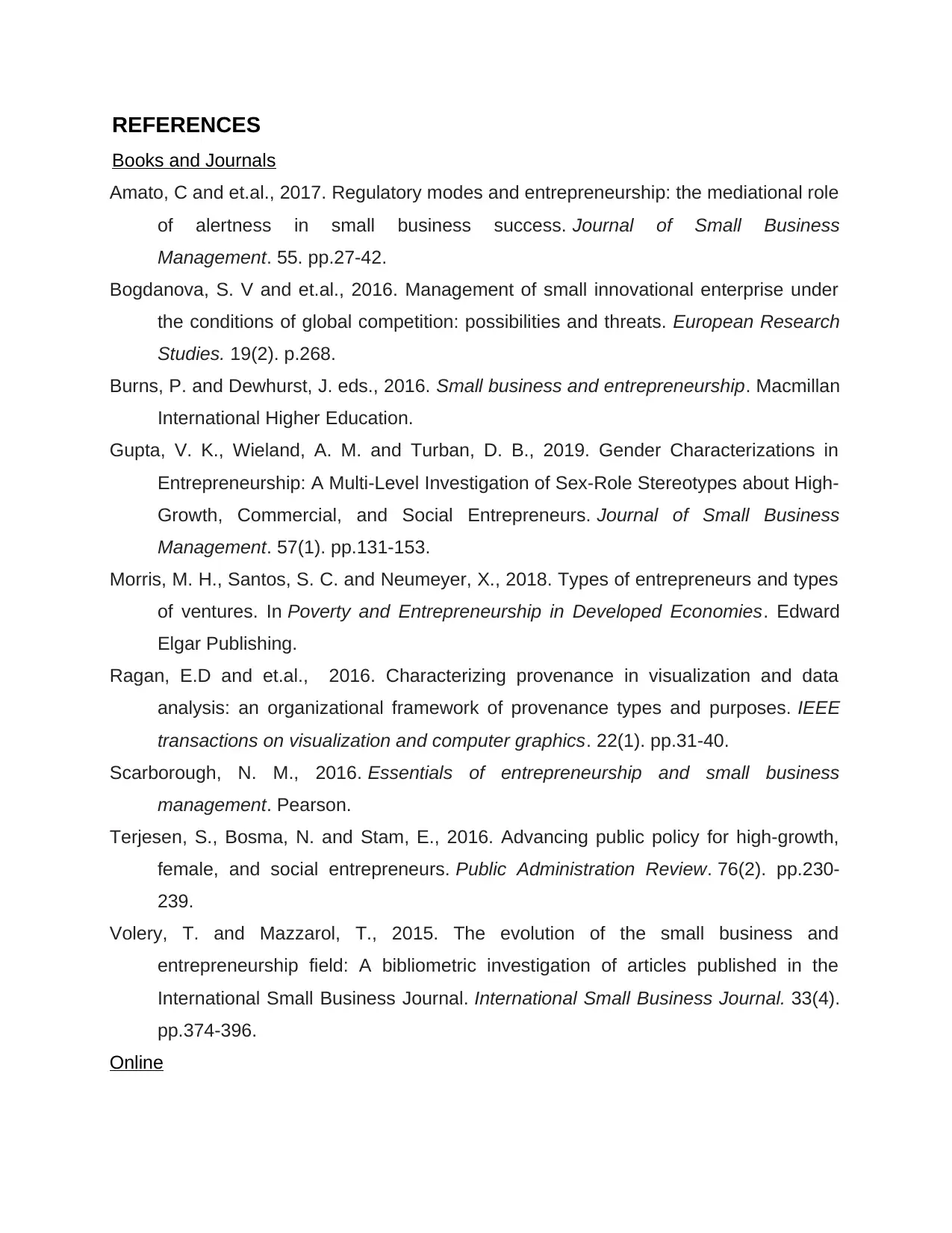
REFERENCES
Books and Journals
Amato, C and et.al., 2017. Regulatory modes and entrepreneurship: the mediational role
of alertness in small business success. Journal of Small Business
Management. 55. pp.27-42.
Bogdanova, S. V and et.al., 2016. Management of small innovational enterprise under
the conditions of global competition: possibilities and threats. European Research
Studies. 19(2). p.268.
Burns, P. and Dewhurst, J. eds., 2016. Small business and entrepreneurship. Macmillan
International Higher Education.
Gupta, V. K., Wieland, A. M. and Turban, D. B., 2019. Gender Characterizations in
Entrepreneurship: A Multi‐Level Investigation of Sex‐Role Stereotypes about High‐
Growth, Commercial, and Social Entrepreneurs. Journal of Small Business
Management. 57(1). pp.131-153.
Morris, M. H., Santos, S. C. and Neumeyer, X., 2018. Types of entrepreneurs and types
of ventures. In Poverty and Entrepreneurship in Developed Economies. Edward
Elgar Publishing.
Ragan, E.D and et.al., 2016. Characterizing provenance in visualization and data
analysis: an organizational framework of provenance types and purposes. IEEE
transactions on visualization and computer graphics. 22(1). pp.31-40.
Scarborough, N. M., 2016. Essentials of entrepreneurship and small business
management. Pearson.
Terjesen, S., Bosma, N. and Stam, E., 2016. Advancing public policy for high‐growth,
female, and social entrepreneurs. Public Administration Review. 76(2). pp.230-
239.
Volery, T. and Mazzarol, T., 2015. The evolution of the small business and
entrepreneurship field: A bibliometric investigation of articles published in the
International Small Business Journal. International Small Business Journal. 33(4).
pp.374-396.
Online
Books and Journals
Amato, C and et.al., 2017. Regulatory modes and entrepreneurship: the mediational role
of alertness in small business success. Journal of Small Business
Management. 55. pp.27-42.
Bogdanova, S. V and et.al., 2016. Management of small innovational enterprise under
the conditions of global competition: possibilities and threats. European Research
Studies. 19(2). p.268.
Burns, P. and Dewhurst, J. eds., 2016. Small business and entrepreneurship. Macmillan
International Higher Education.
Gupta, V. K., Wieland, A. M. and Turban, D. B., 2019. Gender Characterizations in
Entrepreneurship: A Multi‐Level Investigation of Sex‐Role Stereotypes about High‐
Growth, Commercial, and Social Entrepreneurs. Journal of Small Business
Management. 57(1). pp.131-153.
Morris, M. H., Santos, S. C. and Neumeyer, X., 2018. Types of entrepreneurs and types
of ventures. In Poverty and Entrepreneurship in Developed Economies. Edward
Elgar Publishing.
Ragan, E.D and et.al., 2016. Characterizing provenance in visualization and data
analysis: an organizational framework of provenance types and purposes. IEEE
transactions on visualization and computer graphics. 22(1). pp.31-40.
Scarborough, N. M., 2016. Essentials of entrepreneurship and small business
management. Pearson.
Terjesen, S., Bosma, N. and Stam, E., 2016. Advancing public policy for high‐growth,
female, and social entrepreneurs. Public Administration Review. 76(2). pp.230-
239.
Volery, T. and Mazzarol, T., 2015. The evolution of the small business and
entrepreneurship field: A bibliometric investigation of articles published in the
International Small Business Journal. International Small Business Journal. 33(4).
pp.374-396.
Online
⊘ This is a preview!⊘
Do you want full access?
Subscribe today to unlock all pages.

Trusted by 1+ million students worldwide
1 out of 13
Related Documents
Your All-in-One AI-Powered Toolkit for Academic Success.
+13062052269
info@desklib.com
Available 24*7 on WhatsApp / Email
![[object Object]](/_next/static/media/star-bottom.7253800d.svg)
Unlock your academic potential
Copyright © 2020–2025 A2Z Services. All Rights Reserved. Developed and managed by ZUCOL.





